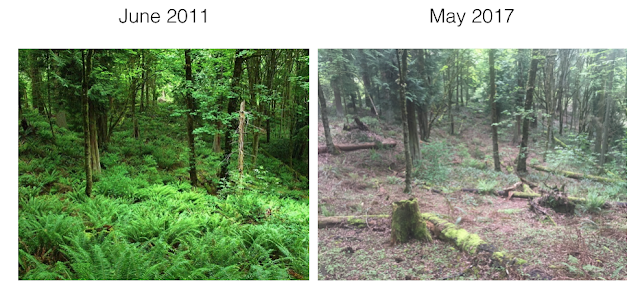New Posts (please scroll down):
December 2018: request for research proposals, site visit by LSU plant pathologist
October 2018: two experiments, possible insight into mechanisms of spread
Since 2014 we have been observing and attempting to understand a dramatic die-off of the dominant understory sword fern species, Polystichum munitum, in the 120-acre old growth "Magnificent Forest" in Seattle's Seward Park.
Extensive lab and field work, consultations with fern experts throughout the US, and recent reports of die-off from elsewhere in the Puget Lowlands of Washington state (see annotated regional map), lead us to conclude with considerable confidence:
Please add your own observations at our iNaturalist project.
- The die-off is caused by an (as yet unidentified) pathogen
- Climate change may be a contributing factor, but until the proximal cause of the die-off is determined, the role of climate change can not be known.
- Drought is probably not a cause (see rainfall records below).
- Is unprecedented, not part of the P.munitum life cycle, in which ferns colonize open ground, do not reproduce under a closed canopy, with individual plants living for hundreds of years.
- Holds implications for the forest at Seward Park, and for other forests in the region.
Some selected blog entries
- Die-off reported from Snohomish County, Lord Hill Park (January 2018)
- Extensive die-off confirmed on Bainbridge Island and the NE tip of the Olympic Peninsula (December 2017)
- Narrative Essay - an overview
- Soil Analysis (June 2017)
- King 5 video (2 minutes, May 5th 2017)
- KUOW (27 july 2017)
- Sierra Magazine (August 2017) by Sarah DeWeerdt
- Seattle Precipitation Records (2012-2016, evidence against drought/die-off causality)

No comments:
Post a Comment